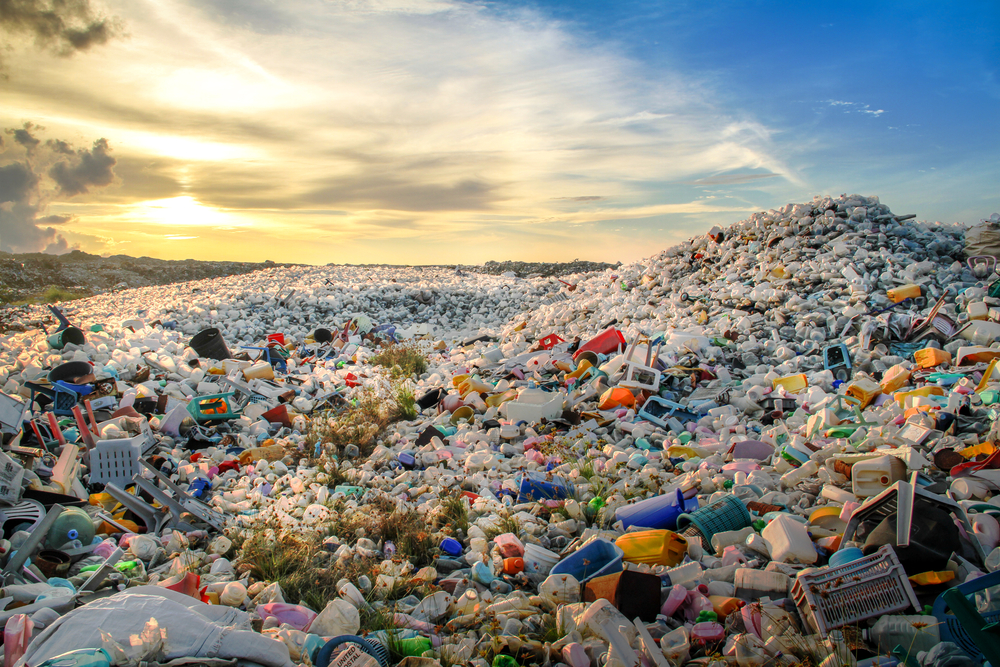
Image Credit: MOHAMED ABDULRAHEEM/Shutterstock.com
Almost every piece of plastic ever made – all 8.3 billion tons of it – still exists somewhere on the planet. When plastics were first invented over 70 years ago, little thought was given to the long-term consequences of its lengthy lifespan, such as the danger it poses to wildlife (and humans), and how long it takes to decompose. Scientists from the University of California Santa Barbara have developed an upcycling technology to help reduce plastic waste.
What is Polyethylene?
Around one-third of all plastics produced contain polyethylene, a lightweight, durable thermoplastic with a global value of $200 billion per year. Such plastics are cheap and easy to produce. Polyethylene has become much more diverse over time and is used in everything from food and drink storage, to toys and medical equipment.
Plastics are particularly useful as they are chemically inert, meaning they do not react with other environmental components. For example, a plastic pipe will not corrode like a metal one, and plastic coatings can withstand higher temperatures than other alternatives. However, this also means they are much more persistent – they hang around for long periods, in some cases taking almost 1000 years to decompose.
While it is much easier to throw away the plastic item once it has reached the end of its useful life than it is to recycle it, a plastic’s longevity means it can lay in the environment, slowly breaking down for years and presenting a hazard to wildlife. It also leaches into watercourses and ultimately becomes a danger to human life.
Solving the Plastic Problem
Many research groups are focused on saving the planet from the scourge of plastic that envelopes it, including Susannah Scott and Mahdi Abu-Omar from the University of California Santa Barbara.
The duo has developed a one-pot, low-temperature method to upcycle polyethylene waste into high-value alkylaromatic molecules – specifically alkylbenzenes - used in many industrial chemicals and consumer products.
"There are many positive things about plastics that we have to keep in view," says Scott, chemistry and chemical engineer professor. "At the same time, we realize that there is this really serious end-of-life issue which is an unintended consequence."
Why is Plastic Hard to Recycle?
What makes plastics so challenging to recycle chemically are the carbon-carbon, and carbon-hydrogen bonds between atoms, explains Abu-Omar, also a professor of chemical engineering. Much research has focused on reducing plastics into their essential components for sustainability purposes, but this can be energy-intensive.
"On the other hand, if we could directly convert the polymers to these higher-value molecules and completely cut out the high-energy step of going back to these building block molecules, then we have a high-value process with a low energy footprint."
Susannah Scott, the University of California Santa Barbara
Scott and Abu-Omar’s method creates high-value alkylaromatic molecules directly from waste polyethylene plastic using a platinum on alumina (Pt/Al2O3) catalyst. The catalyst serves to break the strong carbon-carbon bonds and rearranges the polymer’s molecular skeleton to form a six-sided ring, characteristic of aromatics.
The resulting alkylaromatic molecules have widespread use in solvents, paints, lubricants, detergents, pharmaceuticals, and many other industrial and consumer products.
The process is low-cost, efficient, requiring fewer steps than conventional methods, and requires no additional solvent or hydrogen like other methods. Furthermore, it is less energy-intensive – this method can reduce the energy of transformation by hundreds of degrees, according to Scott.
"Here's a potential solution," Scott adds. "This is a demonstration of what can be done.” The work published in Science is one in a growing list of possible methods to turn plastic's linear, wasteful economy into a more sustainable, circular one by turning waste polymers destined for landfill into valuable raw materials.
"This is an example of having a second use, where we could make these raw materials more efficiently and with better environmental impact than making them from petroleum," Abu-Omar says. "We dig a hole in the ground, we produce, we make, we use, we throw away. So, in a way, this is really breaking that way of thinking. There's interesting science to be done here that will lead us into new discoveries, new paradigms and new ways of doing chemistry."
The Future of Plastic Recycling
Further research is necessary to see how and where this technology might have the most impact. It could be particularly useful in helping to mitigate the growth of plastic waste, recover some of their value, and could even reduce our reliance on the petroleum used to make plastics.
If nothing else, recycling some of the 8.3 billion tonnes of plastics already produced, and reducing the amount of new plastics needing to be made, can only positively affect sustainability and the environment and reduce our dependence on fossil fuels for plastic production.
Reducing Vehicle Tire Wastage with Space Blue's Graphene Solutions
References and Further Reading
University of California - Santa Barbara (2020), Upcycling polyethylene plastic waste into valuable molecules, ScienceDaily [online], https://www.sciencedaily.com/releases/2020/10/201022143928.htm accessed 5th November 2020.
Zhang F. et al (2020), Polyethylene upcycling to long-chain alkylaromatics by tandem hydrogenolysis/aromatization, Science [online], https://science.sciencemag.org/content/370/6515/437 accessed 5th November 2020.
Disclaimer: The views expressed here are those of the author expressed in their private capacity and do not necessarily represent the views of AZoM.com Limited T/A AZoNetwork the owner and operator of this website. This disclaimer forms part of the Terms and conditions of use of this website.